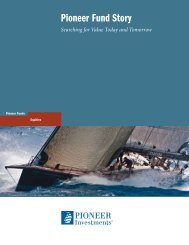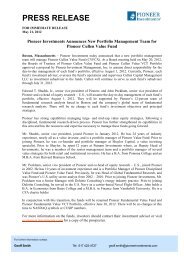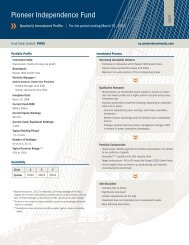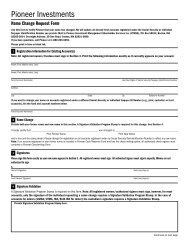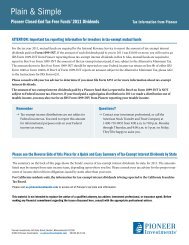Pioneer PRISM XC Variable Annuity - Pioneer Investments
Pioneer PRISM XC Variable Annuity - Pioneer Investments
Pioneer PRISM XC Variable Annuity - Pioneer Investments
You also want an ePaper? Increase the reach of your titles
YUMPU automatically turns print PDFs into web optimized ePapers that Google loves.
opportunities and forced liquidations (“disruptive<br />
trading”). Accordingly, arbitrage trading and disruptive<br />
trading activities (referred to collectively as “market<br />
timing”) may adversely affect the long-term performance of<br />
the investment portfolios, which may in turn adversely<br />
affect contract owners and other persons who may have an<br />
interest in the contracts (e.g., annuitants and beneficiaries).<br />
We have policies and procedures that attempt to detect and<br />
deter frequent transfers in situations where we determine<br />
there is a potential for arbitrage trading. Currently, we<br />
believe that such situations may be presented in the<br />
international, small-cap, and high-yield investment<br />
portfolios (i.e., Dreman Small Cap Value Portfolio, Loomis<br />
Sayles Small Cap Core Portfolio, MFS ® Research<br />
International Portfolio, Oppenheimer Global Equity<br />
Portfolio, <strong>Pioneer</strong> Emerging Markets VCT Portfolio,<br />
<strong>Pioneer</strong> High Yield VCT Portfolio, and <strong>Pioneer</strong> Strategic<br />
Income Portfolio), and we monitor transfer activity in those<br />
portfolios (the “Monitored Portfolios”). We employ<br />
various means to monitor transfer activity, such as<br />
examining the frequency and size of transfers into and out<br />
of the Monitored Portfolios within given periods of time.<br />
For example, we currently monitor transfer activity to<br />
determine if, for each category of international, small-cap,<br />
and high-yield portfolios, in a 12-month period there were:<br />
(1) six or more transfers involving the given category; (2)<br />
cumulative gross transfers involving the given category that<br />
exceed the current account value; and (3) two or more<br />
“round-trips” involving the given category. A round-trip<br />
generally is defined as a transfer in followed by a transfer<br />
out within the next seven calendar days or a transfer out<br />
followed by a transfer in within the next seven calendar<br />
days, in either case subject to certain other criteria.<br />
We do not believe that other investment portfolios present<br />
a significant opportunity to engage in arbitrage trading and<br />
therefore do not monitor transfer activity in those<br />
portfolios. We may change the Monitored Portfolios at any<br />
time without notice in our sole discretion. In addition to<br />
monitoring transfer activity in certain investment<br />
portfolios, we rely on the underlying investment portfolios<br />
to bring any potential disruptive trading activity they<br />
identify to our attention for investigation on a case-by-case<br />
basis. We will also investigate any other harmful transfer<br />
activity that we identify from time to time. We may revise<br />
these policies and procedures in our sole discretion at any<br />
time without prior notice.<br />
Our policies and procedures may result in transfer<br />
restrictions being applied to deter market timing. Currently,<br />
when we detect transfer activity in the Monitored<br />
Portfolios that exceeds our current transfer limits, or other<br />
transfer activity that we believe may be harmful to other<br />
owners or other persons who have an interest in the<br />
contracts, we require all future transfer requests to or from<br />
any Monitored Portfolios or other identified investment<br />
portfolios under that contract to be submitted with an<br />
original signature.<br />
Transfers made under a Dollar Cost Averaging Program, a<br />
rebalancing program or, if applicable, any asset allocation<br />
program described in this prospectus are not treated as<br />
transfers when we evaluate trading patterns for market<br />
timing.<br />
The detection and deterrence of harmful transfer activity<br />
involves judgments that are inherently subjective, such as<br />
the decision to monitor only those investment portfolios<br />
that we believe are susceptible to arbitrage trading, or the<br />
determination of the transfer limits. Our ability to detect<br />
and/or restrict such transfer activity may be limited by<br />
operational and technological systems, as well as our<br />
ability to predict strategies employed by owners to avoid<br />
such detection. Our ability to restrict such transfer activity<br />
also may be limited by provisions of the contract.<br />
Accordingly, there is no assurance that we will prevent all<br />
transfer activity that may adversely affect owners and other<br />
persons with interests in the contracts. We do not<br />
accommodate market timing in any investment portfolios<br />
and there are no arrangements in place to permit any<br />
contract owner to engage in market timing; we apply our<br />
policies and procedures without exception, waiver, or<br />
special arrangement.<br />
The investment portfolios may have adopted their own<br />
policies and procedures with respect to frequent purchases<br />
and redemptions of their respective shares, and we reserve<br />
the right to enforce these policies and procedures. For<br />
example, investment portfolios may assess a redemption fee<br />
(which we reserve the right to collect) on shares held for a<br />
relatively short period. The prospectuses for the investment<br />
portfolios describe any such policies and procedures, which<br />
may be more or less restrictive than the policies and<br />
procedures we have adopted. Although we may not have<br />
the contractual authority or the operational capacity to<br />
apply the frequent trading policies and procedures of the<br />
investment portfolios, we have entered into a written<br />
agreement, as required by SEC regulation, with each<br />
investment portfolio or its principal underwriter that<br />
obligates us to provide to the investment portfolio<br />
promptly upon request certain information about the<br />
25



